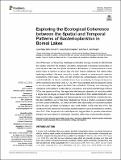Por favor, use este identificador para citar o enlazar a este item:
http://hdl.handle.net/10261/151594COMPARTIR / EXPORTAR:
 SHARE SHARE
 CORE
BASE CORE
BASE
|
|
| Visualizar otros formatos: MARC | Dublin Core | RDF | ORE | MODS | METS | DIDL | DATACITE | |

| Título: | Exploring the ecological coherence between the spatial and temporal patterns of bacterioplankton in boreal lakes |
Autor: | Niño-García, Juan Pablo; Ruiz-González, Clara CSIC ORCID ; Del Giorgio, Paul A. | Palabras clave: | Aquatic bacterial communities Boreal lakes Abundance distributions Temporal-spatial relationship Temporal recruitment Mass effects Environmental sorting Rare biosphere |
Fecha de publicación: | abr-2017 | Editor: | Frontiers Media | Citación: | Frontiers in Microbiology 8: 636 (2017) | Resumen: | One of the major contemporary challenges in microbial ecology has been to discriminate the reactive core from the random, unreactive components of bacterial communities. In previous work we used the spatial abundance distributions of bacterioplankton across boreal lakes of Québec to group taxa into four distinct categories that reflect either hydrology-mediated dispersal along the aquatic network or environmental selection mechanisms within lakes. Here, we test whether this categorization derived from the spatial distribution of taxa is maintained over time, by analyzing the temporal dynamics of the operational taxonomic units (OTUs) within those spatially derived categories along an annual cycle in the oligotrophic lake Croche (Québec, Canada), and assessing the coherence in the patterns of abundance, occurrence, and environmental range of these OTUs over space and time. We report that the temporal dynamics of most taxa within a single lake are largely coherent with those derived from their spatial distribution over large spatial scales, suggesting that these properties must be intrinsic of particular taxa. We also identified a set of rare taxa cataloged as having a random occupancy based on their spatial distribution, but which showed clear seasonality and abundance peaks along the year, yet these comprised a very small fraction of the total rare OTUs. We conclude that the presence of most rare bacterioplankton taxa in boreal lakes is random, since both their temporal and spatial dynamics suggest links to passive downstream transport and persistence in freshwater networks, rather than environmental selection | Descripción: | 12 pages, 4 figures, 1 table, supplementary material http://journal.frontiersin.org/article/10.3389/fmicb.2017.00636/full#supplementary-material | Versión del editor: | https://dx.doi.org/10.3389/fmicb.2017.00636 | URI: | http://hdl.handle.net/10261/151594 | DOI: | 10.3389/fmicb.2017.00636 | Identificadores: | doi: 10.3389/fmicb.2017.00636 e-issn: 1664-302X |
| Aparece en las colecciones: | (ICM) Artículos |
Ficheros en este ítem:
| Fichero | Descripción | Tamaño | Formato | |
|---|---|---|---|---|
| Niño_et_al_2017.pdf | 546,03 kB | Adobe PDF |  Visualizar/Abrir | |
| Niño_et_al_2017_supp.pdf | 213,07 kB | Adobe PDF |  Visualizar/Abrir |
CORE Recommender
PubMed Central
Citations
5
checked on 17-mar-2024
SCOPUSTM
Citations
11
checked on 23-abr-2024
WEB OF SCIENCETM
Citations
10
checked on 28-feb-2024
Page view(s)
285
checked on 24-abr-2024
Download(s)
241
checked on 24-abr-2024

